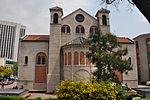Deoksugung

Deoksugung, also known as Gyeongun-gung, Deoksugung Palace, or Deoksu Palace, is a walled compound of palaces in Seoul that was inhabited by members of Korea's Royal Family during the Joseon monarchy until the annexation of Korea by Japan in 1910. It is one of the "Five Grand Palaces" built by the kings of the Joseon Dynasty and designated as a Historic Site. The buildings are of varying styles, including some of natural cryptomeria wood), painted wood, and stucco. Some buildings were built of stone to replicate western palatial structures. In addition to the traditional palace buildings, there are also forested gardens, a statue of King Sejong the Great and the National Museum of Art, which holds special exhibitions. The palace is located near City Hall Station. Deoksugung, like the other "Five Grand Palaces" in Seoul, was heavily damaged during the colonial period of Korea. Currently, only one third of the structures that were standing before the occupation remain.Deoksugung Palace is special among Korean palaces. It has a modern and a western style garden and fountain. The Changing of the Royal Guard, in front of Daehanmun (Gate), is a very popular event for many visitors. The royal guard was responsible for opening and closing the palace gate during the Joseon Dynasty. Outside of the palace is a picturesque road with a stone wall.The Deoksugung Stonewall walkway is at the heart of a popular urban myth in Seoul, as it is said that all couples who walk down this road are fated to break-up.
Excerpt from the Wikipedia article Deoksugung (License: CC BY-SA 3.0, Authors, Images).Deoksugung
Sejong-daero, Seoul
Geographical coordinates (GPS) Address Phone number External links Nearby Places Show on map
Geographical coordinates (GPS)
| Latitude | Longitude |
|---|---|
| N 37.56618 ° | E 126.97485 ° |
Address
덕수궁
Sejong-daero 99
04515 Seoul
South Korea
Open on Google Maps










